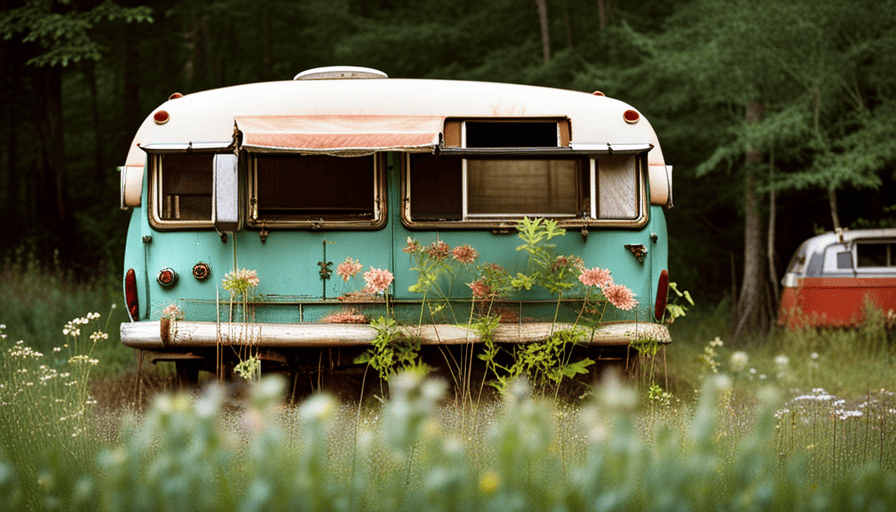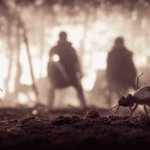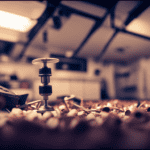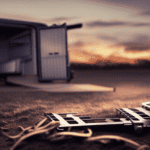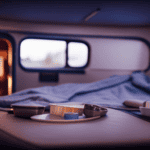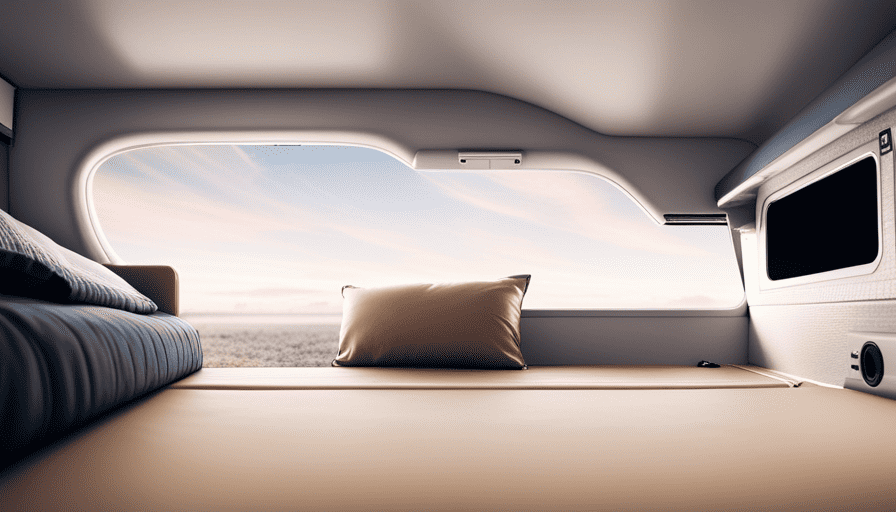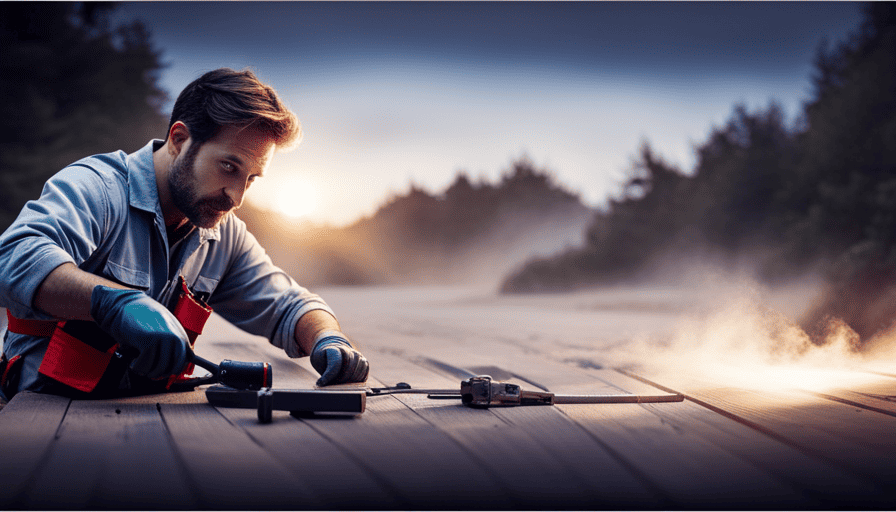Have you ever experienced the annoyance of ants invading the ceiling of your camper? It can feel like you have unwanted guests having a party right above your head! But fear not, my fellow adventurers, because I have the perfect guide to help you get rid of these pesky intruders.
In this article, we will delve into the world of ants, identifying different species and locating their nests or entry points. We will then explore practical solutions to seal cracks and openings in your camper ceiling, effectively cutting off their access.
Ant baits, traps, repellents, and natural remedies will also be discussed, providing you with a range of options to combat these tiny trespassers. And let’s not forget the importance of removing food and water sources, as well as regularly vacuuming or sweeping your camper.
If all else fails, don’t hesitate to call in the professionals! So, let’s roll up our sleeves and banish those ants from our camper ceiling once and for all!
Key Takeaways
- Identifying the specific ant species is important for effective control methods.
- Locating ant nests and entry points in the camper ceiling is crucial for removal.
- Sealing cracks, gaps, and holes in the camper ceiling is necessary to prevent ant entry.
- Using ant baits or traps in areas where ants are commonly seen can help eliminate remaining ants.
Identify the Ant Species
Identifying the ant species is crucial in effectively addressing the issue of ants in the camper ceiling. By understanding the specific ant species, you can determine their behavior patterns and implement appropriate control methods.
Different ant species have distinct preferences for food, nesting habits, and entry points, so it is essential to identify them accurately.
To identify the ant species in your camper, start by observing their behavior. Note their movement patterns, feeding habits, and nesting locations. This will help you narrow down the possibilities and identify the specific species.
Additionally, you can seek assistance from professional entomologists or pest control experts who have experience in ant identification.
Once you have identified the ant species, you can devise an effective plan to eliminate them from your camper ceiling. Different ant species may require different control methods. For instance, if you’re dealing with carpenter ants, it’s crucial to locate their nest and eliminate it. On the other hand, if you’re dealing with sugar ants, focusing on sealing entry points and removing food sources might be more effective.
Identifying the ant species sets the foundation for successful ant control. Now that you know which species you’re dealing with, it’s time to locate the ant nest or entry points and take appropriate action.
Locate the Ant Nest or Entry Points
Look up and notice tiny trails leading to the hidden realm of the industrious invaders, their secret entry points into your cozy camper sanctuary. Finding ant nests and locating their entry points is crucial in effectively getting rid of ants in your camper ceiling. By identifying these areas, you can target your efforts and remove ant colonies more efficiently.
To help you visualize this process, I have created a table below that illustrates the possible locations of ant nests and entry points in your camper ceiling:
| Possible Locations of Ant Nests | Possible Entry Points | Possible Signs of Infestation |
|---|---|---|
| Cracks and gaps in the ceiling | Around windows and doors | Ant trails or droppings |
| Behind electrical outlets | Vents and air ducts | Piles of discarded wings |
| Insulation and wall voids | Plumbing and wiring | Rustling or tapping sounds |
Inspect your camper ceiling carefully, paying close attention to these areas. Once you have located the ant nests or entry points, you can take appropriate measures to remove the ant colonies. This may involve using ant baits, insecticides, or natural remedies, depending on your preferences and the severity of the infestation.
In the next section, we will discuss how to seal cracks and openings in the camper ceiling to prevent ants from reentering. By addressing these vulnerabilities, you can effectively protect your camper sanctuary from future ant invasions.
Seal Cracks and Openings in the Camper Ceiling
To effectively protect your cozy camper sanctuary from future ant invasions, it’s time to take action and seal any cracks or openings in the ceiling. Repairing cracks and sealing openings will not only prevent ants from entering your camper but also prevent leaks and potential water damage. Here are four steps to help you get started:
-
Inspect the ceiling: Carefully examine the entire ceiling, focusing on areas near lights, vents, or any other potential entry points. Look for cracks, gaps, or holes where ants could squeeze through.
-
Gather the necessary materials: You’ll need a silicone-based caulk, a caulking gun, a putty knife, and a ladder or step stool to reach high areas.
-
Clean and prepare the surface: Before applying the caulk, clean the area around the cracks or openings using a mild detergent and warm water. Make sure the surface is dry before proceeding.
-
Seal the cracks and openings: Load the caulk into the caulking gun and carefully fill in the cracks and openings with a steady hand. Smooth out the caulk using a putty knife to ensure a tight seal.
By repairing cracks and sealing openings, you’ll not only keep ants out but also prevent any potential water leaks.
Now, let’s move on to the next step of using ant baits or traps to eliminate any remaining ants in your camper.
Use Ant Baits or Traps
Now, it’s time to tackle the next step and start using ant baits or traps to deal with any remaining pesky ants in your cozy camper sanctuary.
Ant baits and traps are effective ant control methods that can help eliminate ants and prevent their return. These products work by luring ants with a sweet or protein-based bait, which they then carry back to their colony, ultimately leading to the demise of the entire ant population.
When using ant baits or traps, it’s essential to place them in areas where ants are commonly seen, such as near windows, vents, or cracks in the ceiling. Make sure to follow the manufacturer’s instructions on placement and usage. Additionally, consider using multiple baits or traps to increase their effectiveness.
To enhance the effectiveness of ant baits or traps, it’s crucial to implement ant prevention tips alongside their use. Keep your camper clean and free of food debris, as ants are attracted to food sources. Seal any cracks or openings in the camper ceiling to prevent ants from entering in the first place.
As we transition into the next section about applying ant repellents or natural remedies, it’s important to note that using ant baits or traps alone may not completely solve your ant problem. Therefore, it’s advisable to consider additional methods to ensure a comprehensive approach to ant control.
Apply Ant Repellents or Natural Remedies
One effective way to keep pesky ants at bay in your cozy camper sanctuary is by applying ant repellents or natural remedies. When it comes to ant repellents, you have the choice between natural and chemical options.
Natural repellents are a great choice if you prefer to avoid harsh chemicals in your living space. Some popular natural ant repellents include peppermint oil, vinegar, and citrus peels. These ingredients can be easily found in your pantry or local grocery store. Simply mix them with water and spray the solution around areas where ants are commonly seen.
If you prefer chemical repellents, there are various ant sprays and powders available on the market. Look for products that specifically target ants and follow the instructions on the label for best results. While chemical repellents can be effective, it’s important to handle them with care and ensure proper ventilation in your camper.
Another option is to create homemade ant repellents using simple recipes. For example, you can mix equal parts of sugar and borax to create a bait that attracts ants but is toxic to them. Place this mixture in small containers near ant trails to lure them away from your camper.
In the next section, we will explore how to clean and declutter your camper to further discourage ants from invading your space.
Clean and Declutter the Camper
Start by tidying up your cozy home on wheels, making sure to remove any clutter that may be attracting those pesky critters. Keeping your camper clean and organized is key to preventing ant infestations.
Start by going through your belongings and getting rid of any unnecessary items. Clutter provides hiding places for ants and makes it harder to locate and eliminate their nests.
Next, focus on cleaning every nook and cranny of your camper. Dust and vacuum all surfaces, paying special attention to areas where ants may be entering, such as cracks and crevices. Use DIY cleaning solutions, like a mixture of vinegar and water, to wipe down countertops, cabinets, and other surfaces. This not only keeps your camper clean but also helps to deter ants with its strong odor.
In addition to cleaning, consider using storage containers with tight-fitting lids to store food and other items that may attract ants. Keeping food sealed and stored properly will prevent ants from being lured into your camper. Additionally, regularly empty and clean your garbage bins to remove any food residue that could attract ants.
By keeping your camper clean and organized, you’re taking important steps to prevent ants from invading your space. With these organization tips and DIY cleaning solutions, you can create a less appealing environment for ants.
Transitioning into the next section, let’s now focus on removing food and water sources to further deter these pesky critters.
Remove Food and Water Sources
To create a less enticing environment for those pesky critters, you’ll want to eliminate any food and water sources in your camper. Attracting ants with crumbs and spills isn’t a good idea, so follow these steps to prevent ant infestations:
-
Store all food in airtight containers: Ants are attracted to open packages and crumbs, so keep your pantry items tightly sealed. This includes pet food as well.
-
Clean up spills immediately: Any spills, whether it’s a sugary drink or a drop of sauce, should be wiped up right away. Even the tiniest amount can attract ants.
-
Take out the trash regularly: Empty your trash cans frequently, especially if there are food scraps in them. Make sure the trash cans have tight-fitting lids to prevent ants from getting in.
-
Fix any leaks: Ants need water to survive, so fix any leaks or drips in your camper. Check under sinks, around faucets, and behind appliances for any signs of water damage.
By eliminating food and water sources, you’ll greatly reduce the chances of attracting ants into your camper. However, it’s important to also vacuum or sweep the camper regularly to remove any hidden crumbs or food particles that might still be present. This will further discourage ants from making themselves at home in your ceiling.
Vacuum or Sweep the Camper Regularly
Make sure you regularly vacuum or sweep your camper to keep it clean and free of hidden crumbs or food particles that might still be present, as this will discourage ants from making themselves at home and potentially infesting your living space. Regular cleaning is essential in ant prevention, as it helps remove any food sources that may attract these pesky insects.
Did you know that a study found that ants can detect food particles as small as 0.001 grams from a distance of 15 centimeters? This means that even the tiniest crumbs can be enticing to ants and should be eliminated.
To effectively vacuum or sweep your camper, start by removing any loose items or clutter that might obstruct your cleaning efforts. Use a vacuum cleaner or broom to thoroughly clean all surfaces, paying special attention to corners, crevices, and hard-to-reach areas. Be sure to empty the vacuum bag or dustbin outside of the camper to prevent any trapped ants from finding their way back inside.
By regularly cleaning your camper and eliminating potential food sources, you can significantly reduce the chances of an ant infestation. However, if you’ve already tried these prevention methods and are still dealing with ants in your camper, it may be time to consider hiring professional pest control services. These experts have the knowledge and tools to effectively eliminate ants and ensure that your camper remains ant-free.
Hire Professional Pest Control Services
If your attempts at ant prevention have been unsuccessful, it might be worthwhile to consider hiring professional pest control services to effectively address the issue in your camper. While there are various DIY ant control methods available, sometimes the infestation can be too severe or persistent for these methods to be effective. Hiring professionals can provide you with the expertise and specialized tools needed to eliminate the ants and prevent future infestations.
When considering professional pest control services, it is important to weigh the pros and cons. On one hand, professionals have the knowledge and experience to identify the type of ants infesting your camper and implement targeted solutions. They also have access to stronger and more effective pesticides that may not be available to the general public. Additionally, professionals can provide a warranty or guarantee for their services, ensuring that if the ants return, they will come back and address the issue at no additional cost.
On the other hand, hiring professionals can be more expensive compared to DIY methods. It is also important to consider the potential risks associated with pesticide use, especially if you have children or pets in the camper.
To prevent future infestations, it is essential to address the root causes of the ant problem, such as sealing entry points and keeping the camper clean and free of food crumbs.
Prevent Future Infestations
Ensure that all food and crumbs are properly stored and sealed in airtight containers, creating an environment that’s unattractive to ants and discouraging future infestations.
Choosing the right ant repellent is crucial in preventing future ant invasions in your camper. Look for ant repellents that’re specifically designed for indoor use and safe to use in confined spaces. These repellents usually come in the form of sprays or granules that can be easily applied in cracks and crevices where ants may enter. Make sure to read the instructions carefully and follow them accordingly.
In addition to using ant repellents, creating a deterrent for ants in your camper is essential. Start by identifying and sealing any cracks or openings where ants can enter. Use caulk or silicone sealant to seal gaps in windows, doors, and vents. Additionally, consider using ant traps or baits in areas where ants’re commonly seen. These traps’re designed to attract ants and eliminate them, helping to reduce their population and prevent future infestations.
Regularly clean your camper to remove any food debris or spills that may attract ants. Vacuum the floors and wipe down countertops and surfaces with a mixture of vinegar and water to deter ants. Taking these preventive measures’ll help to ensure that your camper remains ant-free and enjoyable for your travels.
Frequently Asked Questions
What are some common signs of an ant infestation in a camper ceiling?
When it comes to dealing with those pesky ants in your camper ceiling, there are a few telltale signs you should be on the lookout for.
Look for small holes or cracks in the ceiling, as ants often use these as entry points.
You might also notice tiny ant trails or even the presence of ant nests.
To effectively remove ants from your camper ceiling, it’s important to identify and seal off their entry points, then use ant baits or natural deterrents to eliminate the infestation.
How do I determine if the ants in my camper ceiling are harmful or benign?
To determine if the ants in my camper ceiling are harmful or benign, I would first observe their behavior. If the ants are simply passing through or foraging for food, they’re most likely harmless. However, if they’re nesting or causing structural damage, they could be harmful.
Additionally, I would consider the potential health risks associated with ants in the camper ceiling, such as allergic reactions or the transmission of disease. It’s always best to consult with a pest control professional for a thorough assessment.
Are there any specific types of ants that are more commonly found in camper ceilings?
Ants in camper ceilings can be a frustrating and unwelcome surprise. There are specific types of ants commonly found in campers, such as carpenter ants and odorous house ants.
Carpenter ants can cause structural damage, while odorous house ants are known for their unpleasant odor. To prevent ants from entering campers, it’s essential to keep the area clean, seal any cracks or openings, and eliminate any food sources.
Regular inspections and professional pest control can also help keep ants at bay.
Can ants cause damage to the structural integrity of the camper ceiling?
Yes, ants in a camper ceiling can indeed cause damage to the structural integrity and electrical systems. They can weaken the ceiling materials and potentially compromise its stability as they build their nests and tunnels. Additionally, ants may chew through electrical wires, creating a fire hazard. To safely remove ants from the camper ceiling, it’s important to locate and eliminate the ant colony, seal off any entry points, and clean the affected area thoroughly to prevent their return.
Are there any DIY methods to prevent ants from entering the camper ceiling in the future?
To effectively keep ants out of the camper ceiling, there are several DIY methods you can try.
One helpful technique is to seal any cracks or openings where ants could enter. Using caulk or weatherstripping, ensure that there are no access points.
Another option is to create a barrier using ant repellent spray or natural deterrents like vinegar or essential oils.
Regularly cleaning and removing food sources will also discourage ants from making their way into the camper ceiling.
Conclusion
Well, after following all the steps and implementing the necessary measures, I can proudly say that I’m now ant-free in my camper! It’s amazing how a little determination and some helpful tips can make such a big difference.
I feel a sense of relief and peace knowing that my camper is now a safe and ant-free zone. It’s incredible how something as small as ants can cause such a nuisance, but with a little effort, I managed to overcome this challenge.
Now, I can truly enjoy my camper without any unwanted guests.


